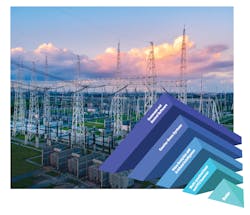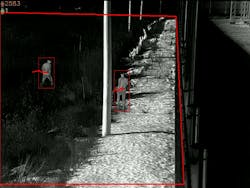This article originally appeared in the August 2022 issue of Security Business magazine. When sharing, don’t forget to mention Security Business magazine on LinkedIn and @SecBusinessMag on Twitter.
For years, standard perimeter intrusion detection systems (PIDS) have relied on technologies like fences, visible surveillance cameras, security lighting, barbed wire, and access control; however, evolving threats to the perimeter seem to have outpaced these tried-and-true security devices, as more and more critical infrastructure sites have reported perimeter breaches.
Evolving PIDS systems to meet a variety of perimeter threats is especially important for critical infrastructure sites in the United States. As the COVID-19 pandemic and other recent crises have proven, because of the interconnectedness of nearly every global system, it is now true that the failure of any mission critical facility can prove catastrophic. Whether it be a data center, hospital, airport, or oil well, this applies to mission critical facilities of all kinds both in the U.S. and across the globe.
“One attack on a single point of failure could lead to the disruption or destruction of multiple vital systems in the country directly affected, and a ripple effect worldwide,” explained Jürgen Stock, the Secretary-General of the International Criminal Police Organization (ICPO-INTERPOL), during a presentation to the UN Security Council in 2017.
As threats to physical perimeters proliferate, the responsibility will fall on security integrators to design end-to-end, future proofed PIDS capable of detecting, classifying and deterring threats long before they are able to reach an end user’s perimeter. When it comes to perimeter security to protect the most vital assets, systems, and networks in critical infrastructure, one of the best available strategies for detecting, classifying, and mitigating intruders is to create a multi-layered system leveraging the most current and powerful PIDS technologies and strategies available.
How to Build a Multilayered PIDS
Today's leading PIDS are purpose-built to preempt and disrupt potential perimeter intrusions. These end-to-end systems layer perimeter surveillance devices – such as visible and thermal cameras, radar, and artificial intelligence (AI)-enabled video analytics – to create robust system redundancy and guarantee situational awareness.
Expanding on existing systems, a multi-layered PIDS not only optimizes critical infrastructure end-users to face ongoing threats, they also equip them to address threats as they evolve.
The most powerful multilayered PIDS, today, integrate multiple, complementary sensors for the most reliable threat recognition and response that not only streamlines intrusion detection, visual verification, and threat mitigation, but also an investment in a system that is built to evolve as future threats emerge.
Here’s a layer-by-layer guide to creating this type of perimeter protection system:
Layer One: Radar
High-resolution radar designed to accurately detect personnel and vehicles hundreds of meters away in virtually any climate, weather, or lighting condition can scan an entire facility’s perimeter every second. Integrated in an overlapping array with a variety of other radar units, they can also conform to terrain profiles and protect larger areas, depending on the size and extent of a perimeter. Built to surveil areas far beyond a physical fence line, these devices provide advanced warning of any and all incoming threats, whether they are ground- or air-based.
Layer Two: Multi-spectral Fixed and PTZ Cameras
Pairing multi-spectral cameras featuring visible and high-definition thermal sensors with radar can provide immense benefits for active operators. Once a radar detects an object of interest, it will identify the coordinates and direct the PTZ camera to focus directly to thatLayer Three: Video Analytics and Artificial Intelligence
Industry-leading video analytics use artificial intelligence to enable intrusion detection, object classification, and target tracking and equip users to detect minute, pixel-level changes in a camera’s field of view (FOV) and issue instantaneous alerts based on established alarm parameters for advanced warning of potential intruders.
When integrated into a video management system (VMS), onboard convolutional neural network (CNN) video analytics software, in particular, can also manually analyze tens of thousands of images from security application datasets, further strengthening the VMS’s ability to accurately classify distinct similarities between different kinds of objects. As many threats to perimeters can quickly shift position, deploying tracking capabilities is a critical piece of an end-to-end, multilayered PIDS.
Layer Four: Counter-Drone Systems
Though protecting a physical perimeter on the ground level is vital, it is just as important to equip a mission critical PIDS to mitigate threats from the air. Any PIDS deploying a multi-layered approach can also utilize this expansive and preemptive situational awareness to address threats from Unmanned Aerial Systems (UAS), also known as drones.
For perimeters that enclose large, open spaces and expansive facilities, radars purpose-built to detect UAVs, integrated with premium, multi-spectral cameras enable perimeter protection from both ground- and air-based threats. Employing jammers or spoofers designed to intercept adversarial drones, eliminate their RF and GPS communications links, and render them inoperable alongside this multilayered solution optimizes a PIDS as a proper C-UAS solution.
Layer Five: Command and Control Software
To bring the above devices together, PIDS require a highly customizable and user-friendly video management software (VMS) that can grow as security needs grow. Powerful VMS give operators the ability to manage any number of devices to improve operational efficiency by unifying device management under one centralized management interface for effortless administration, reliable performance, and peace of mind.
Integrator Checklist
As security integrators work to achieve this multi-layered defense strategy for their critical infrastructure and related customers, here are a handful of questions you should keep in mind:
- What are the biggest gaps in your customer’s existing PIDS that you are looking to close?
- What kinds of threats are your customers looking to mitigate?
- Consider the vendors you already work with—what additional technologies do they offer that you might be able to upsell to customers for asset protection? How easily are these devices layered?
- Is your VMS provider coming out with new integration capabilities that are able to expand beyond traditional security for added value?





